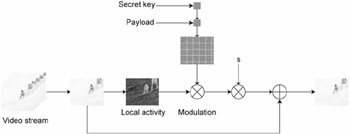4.3 Real-Time Watermarking
4.3 Real-Time Watermarking
Real-time can be an additional specification for video watermarking. It was not a real concern with still images. When a person wants to embed a watermark or to check the presence of a watermark in an image, a few seconds is an acceptable delay. However, such a delay is unrealistic in the context of the video. Frames are indeed sent at a fairly high rate, typically 25 frames per second, to obtain a smooth video stream. At least the embedder or the detector, and even sometimes both of them, should be able to handle such a rate. In the context of broadcast monitoring, the detector should be able to detect an embedded watermark in real-time. In a VOD environment, the video server should be able to insert the watermark identifying the customer at the same rate that the video is streamed. In order to meet the real-time requirement, the complexity of the watermarking algorithm should obviously be as low as possible. Moreover, if the watermark can be inserted directly into the compressed stream, this will prevent full decompression and recompression and, consequently, it will reduce computational needs. This philosophy has led to the design of very simple watermarking schemes. Exploiting the very specific part of a video compression standard can lead to very efficient algorithms. An MPEG encoded video stream basically consists of a succession of Variable Length Code (VLC). A watermark can consequently be embedded in the stream by modifying those VLC code words [31]. The MPEG standard uses indeed similar VLC code words i.e. with the same run length, the same VLC size and a quantized level difference of one. Such VLC code words can be used alternatively in order to hide a bit.
Just Another Watermarking System (JAWS)
When considering real-time, the watermarking algorithm designed by Philips Research is often considered as a reference. The JAWS algorithm was originally designed for broadcast monitoring and is actually one of the leading candidates for watermarking in DVD. The real-time requirement is met by using simple operations at video rate and only a few complex ones at a much lower rate [25].
The embedding process is depicted in Figure 42.8. First of all, an MxM normally distributed reference pattern pr is generated with a secret key. In a second step, a reference watermark wr is created according to the following equation:
| (42.1) |

Figure 42.8: Description of JAWS embedding
where the shift(.) function returns a cyclically shifted version of the reference pattern pr. In JAWS, the message is completely encoded by the shift between the two reference patterns. This reference watermark is then tiled, possibly with truncation, to obtain the full-size watermark w. For each frame, this watermark is then perceptually shaped so that the watermark insertion remains imperceptible. Each element i of the watermark is scaled by the local activity λ(i) of the frame, given by Laplacian filtering. The flatter the region is, the lower the local activity is. This is coherent with the fact that the human eye is more sensitive to noise addition in flat regions of an image. Finally, the watermark is scaled by a global factor s and added to the frame F in order to obtain the watermarked frame Fw. As a result, the overall embedding process can be expressed as:
| (42.2) |
On the detector side, the incoming frames are folded, summed and stored in an MxM buffer B. The detectors look then for all the occurrences of the reference pattern pr in the buffer with a two dimensional cyclic convolution. Since such an operation is most efficiently computed in the frequency domain, this leads to Symmetrical Phase Only Matched Filtering (SPOMF) detection which is given by the following equation:
| (42.3) |
where FFT(.) and IFFT(.) are respectively the forward and inverse Fourier transforms and x* denotes the complex conjugation. Figure 42.9 shows the result of such a detection. Two peaks can be isolated which correspond to the two occurrences of pr in wr. The peaks are oriented accordingly to the sign before their associated occurrence of pr in Equation (1). Because of possible positional jitter, all the relative positions between the peaks cannot be used and relative positions are forced to be multiple of a grid size G. Once the detector has extracted the peaks, the hidden payload can be easily retrieved. The attentive reader would have noticed that this scheme is inherently shift invariant since a shifting operation does not modify the relative position of the peaks. Significant improvements have been added to this scheme afterwards. For example, shift invariance has been further exploited in order to increase the payload [35] and simple modifications permitted to obtain scale invariance [50].

Figure 42.9: Example of SPOMF detection
EAN: 2147483647
Pages: 393